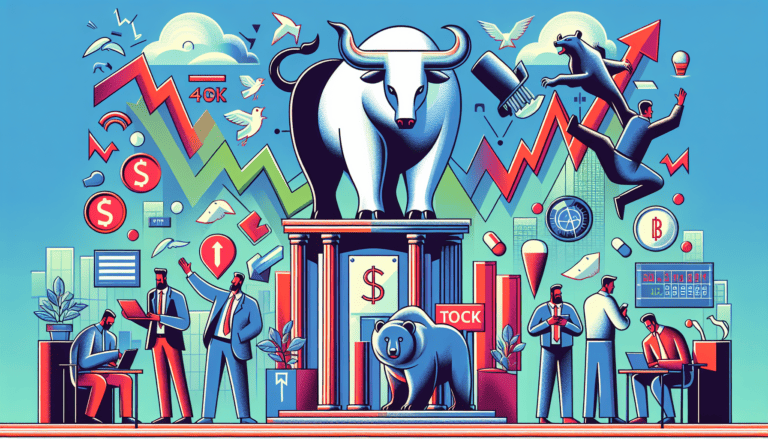Understanding Stock Exchanges – A Close Look

Introduction to Financial Markets
The financial markets are a cornerstone of the global economy, serving as the lifeblood for capital flow and investment opportunities. They encompass various institutions, participants, and mechanisms that collectively facilitate the exchange of financial securities.
Role of Stock Exchanges
Stock exchanges are pivotal entities within the financial markets, acting as centralized marketplaces where buyers and sellers can engage in trading stocks. They ensure liquidity, which is the ease with which securities can be bought or sold without affecting their price significantly, and fair pricing of stocks, which is crucial for the efficient functioning of the markets. For those understanding stock exchanges, recognizing their role in liquidity and price determination is fundamental.
Moreover, stock exchanges are instrumental in capital formation for companies. They provide a venue for companies to access public funds through mechanisms like initial public offerings (IPOs). This process is vital for companies looking to expand their operations or undertake new projects by selling shares to the public, thereby raising the required capital.
Additionally, stock exchanges reflect the economic strength of a country by listing companies of various sizes, from well-established corporations to emerging startups. They offer investors the opportunity to earn returns on their investments by purchasing shares of these companies and potentially receiving dividends.
Regulatory Bodies
The operations of stock exchanges are governed by regulatory bodies to ensure fairness, transparency, and investor protection. In the United States, for instance, the Securities and Exchange Commission (SEC) is the primary regulatory agency overseeing the securities industry, including stock exchanges. The SEC enforces securities laws designed to promote full public disclosure, protect investors against fraudulent and manipulative practices in the market, and oversee the corporate takeover actions in the United States.
Regulatory agencies across the globe are tasked with similar responsibilities to maintain the integrity of financial markets. They establish rules that stock exchanges and market participants must follow, including standards for listing securities, market surveillance, and the reporting of trades. The presence of such regulatory oversight is essential to maintain investor confidence and ensure the smooth functioning of the markets (Investopedia).
Understanding the role of regulatory bodies is a crucial aspect of stock market regulation and oversight, as these institutions help to mitigate risks, including stock market bubbles and crashes, and safeguard the interests of all market participants.
By grasping the fundamental concepts of stock exchanges and the regulations that govern them, beginner investors can better navigate the complex world of financial markets and make more informed investment decisions. For further exploration of how stocks are traded, readers can delve into the mechanics of stock trading.
Key Stock Exchanges
An understanding of stock exchanges is fundamental for beginner investors entering the world of finance. Among the numerous exchanges globally, two in the United States stand out due to their size, influence, and the volume of trading activity: The New York Stock Exchange (NYSE) and The Nasdaq Stock Market.
The New York Stock Exchange
The New York Stock Exchange, often referred to as “The Big Board,” is the largest stock exchange in the world by market capitalization. With over 2,800 companies listed and a combined market capitalization exceeding $25 trillion, it represents a significant portion of the global economy (Investopedia). The NYSE is home to many of the world’s largest corporations, spanning various industries.
Key attributes of the NYSE include:
- Location: New York City, USA
- Number of Listings: Over 2,800 companies
- Market Capitalization: Over $25 trillion
- Notable Listings: Include blue-chip companies across diverse sectors
The NYSE is known for its stringent listing requirements, ensuring that only companies with a solid financial foundation are traded. It operates under a hybrid model that allows for electronic trading and floor trading, where brokers can execute trades on behalf of their clients. For individuals interested in the process of initial public offerings (IPOs) and how companies get listed on the NYSE, extensive resources are available to explain these mechanisms in detail.
The Nasdaq Stock Market
The Nasdaq Stock Market is the second-largest exchange in the world and a formidable competitor to the NYSE. It is renowned for its high concentration of technology companies and innovative startups, with a particular emphasis on growth-oriented businesses. Nasdaq’s market capitalization is substantial, though it trails the NYSE in this regard (Investopedia).
Key attributes of the Nasdaq include:
- Location: New York City, USA
- Specialization: Technology and internet-based companies
- Market Capitalization: Trailing the NYSE, yet substantial
- Notable Listings: Many of the world’s leading tech companies
Nasdaq operates entirely through electronic trading, without a physical trading floor. This modern approach has made it an attractive venue for companies involved in cutting-edge industries. Investors looking to understand more about electronic trading can refer to electronic trading and its impact on the financial markets.
Both the NYSE and Nasdaq are central to the operation of financial markets, providing liquidity and a platform for price discovery. Investors can learn more about how these exchanges function within the broader ecosystem by exploring the mechanics of stock trading, and how they relate to major global stock exchanges. Understanding these institutions is crucial for investors aiming to navigate the stock markets effectively and make informed investment decisions.
The Mechanics of Trading
Understanding how stocks are traded on stock exchanges is fundamental for beginner investors. The process involves various market participants, including market makers and specialists, who ensure that trading operations are efficient and fair.
How Stocks Are Traded
The trading of stocks is a complex process that takes place on stock exchanges and involves the buying and selling of company shares. When a company decides to go public, it will offer its shares through an initial public offering (IPO). Once the shares are listed on an exchange, investors can trade them.
The process typically begins with an investor placing an order through a broker, who then routes the order to the exchange. Orders can be of various types, such as market orders, limit orders, or stop orders, each with its own conditions for execution.
Stocks are traded electronically on modern exchanges, utilizing sophisticated algorithms and trading platforms. This electronic system matches buy and sell orders, ensuring that trades are completed at the best available prices. The transition to electronic trading has significantly increased the speed and efficiency of the trading process.
Market Makers and Specialists
Market makers and specialists are key players in the mechanics of trading on stock exchanges. They both work to provide liquidity, which is crucial for the smooth operation of financial markets.
Market Makers
Market makers are typically financial institutions or specialized firms that actively quote buy and sell prices for stocks. They are committed to trade at these prices and earn profits from the spread, the difference between the buying and selling prices.
| Role | Description |
|---|---|
| Liquidity Provider | Ensure there are always buyers and sellers for securities |
| Price Stability | Help facilitate price discovery and market efficiency |
| Counterparty | Step in as a counterparty to trades lacking natural buyers or sellers |
Market makers are equipped with advanced trading systems and algorithms that help manage their positions and market exposure (Corporate Finance Institute). They also employ risk management strategies to contend with risks such as adverse selection and inventory risk.
Specialists
Specialists are responsible for the oversight of trading for specific stocks, matching buy and sell orders, and maintaining a fair and orderly market. They manage supply and demand for the stocks they oversee and may intervene to buy or sell stock to preserve market liquidity.
| Responsibility | Description |
|---|---|
| Order Matching | Match buy and sell orders for assigned stocks |
| Market Oversight | Maintain a fair and orderly market environment |
| Regulation Compliance | Adhere to strict trading rules and guidelines |
Specialists must operate within regulatory frameworks and guidelines to ensure fair trading practices and prevent market manipulation. They are subject to oversight by regulatory bodies and are required to maintain transparency and efficiency in their operations (Investopedia).
Both market makers and specialists are crucial for the mechanics of stock trading, ensuring that exchanges function properly and that securities can be bought and sold with ease. For those new to investing, grasping the roles of these entities is an important step in understanding stock exchanges and the broader financial markets.
Types of Financial Markets
Financial markets play a critical role in the global economy, providing a platform for raising capital, trading securities, and discovering prices. Understanding the different types of financial markets is essential for beginner investors looking to navigate the world of stock markets and exchanges.
Exchange Trading
Exchange trading refers to the buying and selling of securities on formal exchanges—a structured environment with set rules and regulations. These exchanges, such as the New York Stock Exchange (NYSE) and the Nasdaq Stock Market, are well-known entities that provide a regulated and transparent platform for market participants (Investopedia).
Securities traded on exchanges include stocks, bonds, and various other financial instruments. The NYSE is the largest stock exchange in the world, boasting over 2,800 listed companies and a staggering market capitalization surpassing $25 trillion. It operates as a physical trading floor as well as electronically, offering a hybrid model for traders.
In contrast, the Nasdaq is a fully electronic exchange, with all trading occurring over a network of computers, eliminating the need for a physical trading floor (source). This evolution towards electronic trading has enhanced the efficiency and accessibility of exchange markets, as detailed in our article on electronic trading and its impact.
Exchanges serve as a vital component of the financial infrastructure by aiding companies in raising capital via initial public offerings (IPOs) and providing investors with a venue to invest and divest their holdings in a regulated environment.
Over-the-Counter Markets
Over-the-counter (OTC) markets differ significantly from formal exchanges. They are decentralized networks where trading is not conducted through a central exchange but rather directly between parties. The OTC markets are characterized by a less formal trading environment with dealers and brokers who act as market makers by quoting prices and facilitating trades.
OTC markets offer trading in instruments such as currencies, bonds, and structured products. These markets are known for their flexibility and the ability to tailor contracts to the specific needs of the trading parties. However, they are typically less transparent than exchange markets, with fewer regulations, which can increase risks for investors. The securities that contributed to the financial crisis of 2007 were predominantly traded in OTC markets, highlighting the potential dangers associated with these types of trades (IMF).
Despite the increased risk, OTC markets remain a crucial part of the financial ecosystem, particularly for instruments that may not qualify for listing on formal exchanges. For investors interested in OTC markets, it’s important to conduct thorough stock market analysis techniques and understand the risks associated with OTC trading.
By comprehending the distinct features of exchange trading and over-the-counter markets, beginner investors can make more informed decisions and select the appropriate venues for their investment strategies. Whether through the structured setting of an exchange or the flexible arrangements of an OTC market, investors have multiple avenues to participate in the financial markets.
Factors Influencing the Markets
The performance of the stock market is often seen as a reflection of the broader economy and geopolitical landscape. Understanding the myriad of factors that can influence market dynamics is essential for beginner investors looking to navigate the complexities of understanding stock exchanges.
Economic Conditions
Economic indicators such as inflation rates, gross domestic product (GDP) growth, unemployment figures, and interest rates are key elements that affect the stock market. These factors can directly impact corporate earnings and consumer spending, which in turn influence stock prices. For instance, high-interest rates can increase borrowing costs for companies, leading to lower profitability and potentially causing stock prices to fall.
Here’s a simple table to illustrate how select economic conditions might impact the stock market:
| Economic Indicator | Potential Impact on Stock Market |
|---|---|
| GDP Growth | Higher growth can lead to increased investor confidence and rising stock prices. |
| Inflation | High inflation may lead to increased costs for companies and consumers, possibly resulting in lower stock prices. |
| Interest Rates | Rising interest rates can reduce spending and investment, potentially leading to a downturn in stock prices. |
These economic conditions are closely monitored by market participants as they can provide insight into the health of the economy and the potential direction of the stock market. Learning about market capitalization and its importance can also help investors understand the value being traded in the market.
Political Events
Political events, ranging from elections to changes in government policies and international relations, can significantly affect the stock market. For example, a new government policy that favors a particular industry might lead to an increase in stock prices for companies in that sector. Conversely, geopolitical tensions can create uncertainty and lead to a decrease in investor confidence, causing volatility and potential declines in the market.
Investors should stay informed about political developments both domestically and internationally, as these events can have immediate and far-reaching effects on their portfolios. Understanding how stock market regulation and oversight functions can also help investors grasp how political decisions can influence the trading environment.
Investor Sentiment
Investor sentiment reflects the collective attitude and perception of market participants toward future stock market performance. This sentiment can be swayed by news reports, market trends, and the psychological state of investors. Positive investor sentiment can drive stock prices upward, while negative sentiment can trigger selling and lower stock prices.
It’s crucial for investors to recognize that sentiment can sometimes lead to overreactions in the market. Studying stock market analysis techniques can equip investors with the tools to differentiate between sentiment-driven movements and those based on fundamental changes in the market.
Understanding the interplay between economic conditions, political events, and investor sentiment is vital for anyone seeking to comprehend the stock market’s ebb and flow. These factors are interconnected, often creating a feedback loop that can amplify their individual effects on the market. By recognizing these influences, investors can make more informed decisions and develop strategies to manage risk, such as those discussed in stock market risks and how to manage them.
Understanding Market Indices
Market indices are pivotal tools in understanding stock exchanges and the broader financial markets. They serve as gauges for tracking the performance of a specific set of stocks, enabling investors to gain insights into the health of the economy and individual sectors.
Measuring Market Performance
Market indices measure the performance of the stock market by aggregating the value of a group of stocks into a single number. This makes it easier for investors to compare current price levels with past prices to determine market performance. Indices are calculated using a weighted average of the prices of the constituent stocks, which can be influenced by factors such as market capitalization or price (Investopedia).
These indices provide a snapshot of the overall market performance and act as a benchmark against which the performance of individual stocks or portfolios can be measured. They are essential for investors to gauge market trends, identify investment opportunities, and assess portfolio performance.
Popular Stock Market Indices
Several stock market indices are widely recognized and followed. Here are a few of the most popular ones:
| Index | Description |
|---|---|
| S&P 500 | Represents the performance of 500 large-cap U.S. companies and is considered a benchmark for the U.S. stock market. (Investopedia) |
| Dow Jones Industrial Average (DJIA) | Tracks 30 large, publicly traded companies and is used as an indicator of the overall U.S. economic health. (Investopedia) |
| Nasdaq Composite | Includes over 3,000 stocks listed on the Nasdaq Stock Market, representing various sectors. |
| Russell 2000 | Measures the performance of 2,000 small-cap U.S. companies, providing a comprehensive view of the smaller company segment. |
These indices are not only markers for investors but also for financial professionals, the media, and the public as indicators of market trends and sentiment. The rise and fall of an index can signal economic growth or downturn, affecting investment decisions and strategies. For an in-depth explanation of how these indices work, visit our page on stock market indices explained.
Investors should keep in mind that the performance of stock market indices can be influenced by a multitude of factors, including economic indicators, corporate earnings, geopolitical events, and investor sentiment. These factors can cause fluctuations in the indices, which in turn impact the overall market performance.
By monitoring these indices, beginner investors can develop a better understanding of stock exchanges and the financial markets, aiding them in making more informed investment decisions. To further explore the components of the financial markets, one can read about major global stock exchanges or delve into the processes behind initial public offerings (IPOs).
Risks and Considerations
While investing in the stock market can be a rewarding financial strategy, it’s important to be aware of certain risks and considerations. This section outlines the key aspects of market volatility and regulatory compliance that should be taken into account when understanding stock exchanges.
Market Volatility
Market volatility refers to the frequency and magnitude of price movements in the stock market. Prices of securities can fluctuate widely in the short term due to various factors such as economic news, corporate earnings reports, and geopolitical events. These fluctuations can affect the value of investments and the overall stability of the market.
Investors should consider the following when dealing with market volatility:
- Market Trends and Cycles: Understanding stock market trends and cycles can help investors anticipate periods of higher volatility.
- Investment Horizon: A longer investment horizon can potentially weather short-term market fluctuations.
- Diversification: Spreading investments across different asset classes can mitigate the impact of volatility on a portfolio.
- Risk Tolerance: Assessing one’s risk tolerance can guide investment choices that align with personal comfort levels.
Regulatory Compliance
Stock exchanges operate under strict regulatory frameworks to ensure fair and transparent trading practices. These regulations are enforced by government agencies, such as the Securities and Exchange Commission (SEC) in the United States.
Key aspects of regulatory compliance include:
- Disclosure Requirements: Companies listed on stock exchanges must provide regular financial disclosures, ensuring transparency for investors.
- Market Maker and Specialist Guidelines: Entities such as market makers and specialists are subject to regulatory oversight to maintain fairness and integrity in the market (Investopedia; Corporate Finance Institute).
- OTC Market Differences: Over-the-counter (OTC) markets are less regulated than formal exchanges, posing different risks (IMF).
Investors should be aware of the regulatory environment and how it affects their investments. Understanding stock market regulation and oversight can provide insight into the measures taken to protect investor interests.
By recognizing the inherent risks associated with market volatility and the importance of regulatory compliance, investors can make more informed decisions. It’s essential to conduct thorough research or consult with financial experts before engaging in stock market activities. Resources such as stock market analysis techniques and stock market risks and how to manage them can further aid investors in navigating the complexities of financial markets.





